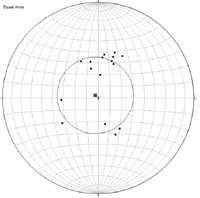Early extension in the Yilgarn Craton: Evidence from Leonora |
| Main
Conclusions Questions and Implications
|
|
In this page we cover the geological evolution of the area north and northwest of Leonora around the Raeside Batholith and the Boxers Well Pluton. One of the main features of this area is the curved boundary between the Raeside Batholith and the overlying mafic-ultramafic greenstones of the Leonora Terrane (Vanderhor and Witt, 1992), the NNW-trending Mount George Zone (Passchier 1994) which separates the Leonora Terrane from the Keith-Kilkenny Tectonic Zone (Hallberg 1985). The latter is comprised not only of the lower mafic-ultramafic greenstones but also calc-alkaline volcanic rocks (dacites and rhyolites) and the late sedimentary sequence of the Pig Well Basin. Passchier (1994) concluded that the Mt George Zone north of Leonora is not a strike-slip shear zone as previously thought, but an early extensional structure overprinted by D2 folding. He suggests that the Mt George Zone could have accommodated E-directed extension to form a graben into which the upper stratigraphic sequences comprising the calc-alkaline volcanic rocks and the Pig Well basin were deposited. Williams and Currie (1993) reported a significant drop in metamorphic grade over a very short distance indicating a loss of crustal section in a drill core on the eastern side of the Raeside Batholith. Passchier (1994) argued against Skarnecki's (1987) suggestion that granite diapirism controlled the structures based on the lack of radial stretching lineation around the Raeside Batholith and to the existence of extension structures away from granite margins. |
|
|
Diorite King: Isoclinal folds in dextral-normal shear zones (N30E/80NW)
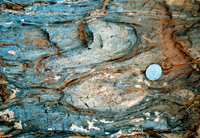 A) Rootless isoclinal quartz folds |
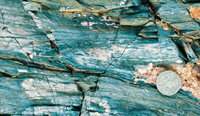 B) Line drawing |
Mt Ross: Normal Shear Zones
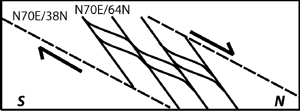
A) Line drawing of a 2m normal shear zone hosting gold in Mt Ross area (310875 x 6823056) |
Mt Ross: Refolded isoclinal folds
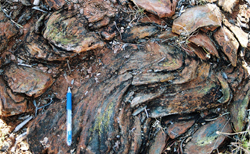
A) Refolded F1 folds |
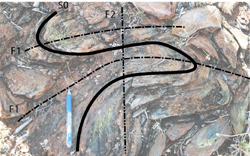 B) Line drawing |
Riviera Pit: Generalized Horizontal Extension
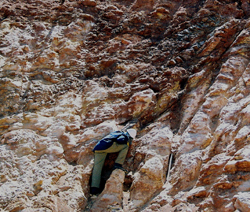
A) Normal fault in weathered granite |
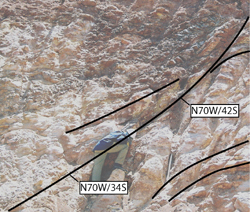 B) Line drawing of fault and dragging of foliation |
Jasper Flat/Auckland
Jasper Flat: F1
Figure 1
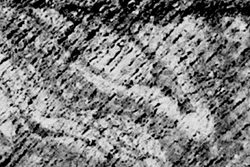 Granite F1 fold in northern wall of Jasper Flat |
Jasper Flat: Refolded folds
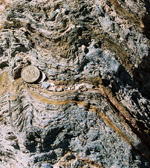
A) Normal fault in weathered granite |
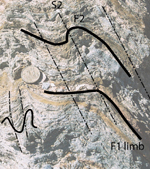 B) Line drawing of fault and dragging of foliation |
|
From Diorite King in the NW to Sons of Gwalia in the SE, over an arc of 90o and a length of 40km, the extension direction gradually rotates in tandem with and roughly at 90o to the orientation of the batholiths margins: extension to the NNW along ENE-trending margin at Mt Ross, to the NNE along the WNW-trending margin at Jasper Flat/Auckland, multidirectional in Riviera/Victor Well area, and to the E along the N-trending margin close to Leonora. Passchier (1994) suggested that the lack of radial stretching lineations around the Raeside Batholith was, together with a number of other evidence, indicative that extension was not related to gneissic doming as had been suggested by Skwarnecki (1987). We showed above that over an arc of 90o extension was radial close to the margins of the batholith, and that it required a vertical axis of maximum shortening. The fact that north directed extension also occurs at Mt Malcolm and at Mt Newman, where deformation cannot be related to granites (Passchier 1994) implies a regional north-directed extension event was not induced by granite doming confirming Hammond and Nisbett (1992) and WIlliams and Whitaker (1993).However, the radial pattern around the Raeside Batholith suggests that extension direction was reoriented at granite contacts and doming of the batholith remains plausible. If this was so, the fact that the smaller Boxers Well pluton was descending in relation to the Raeside Batholith is simply a result of the former being on the margins of the much larger batholith. Develop: Passchier suggests E directed faulting on Mt George to give rise to a graben. This would have to imply a multidirectional extension |
|
|
CLICK ON ANY PHOTO TO VIEW A HIGH RESOLUTION VERSION
